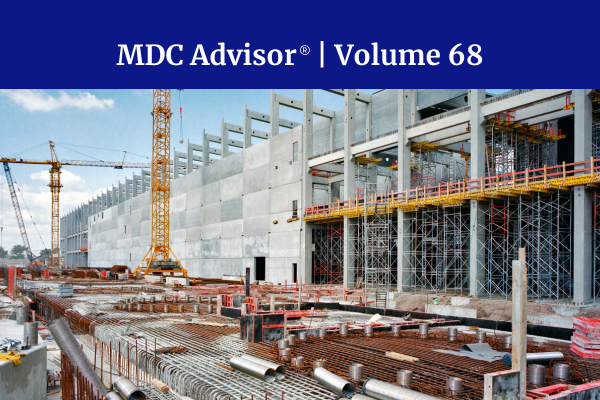
Embracing Your Promotor Fidei Integrated Project Delivery
By E. Mitchell Swann, PE
Featured in the September 2018, MDCAdvisor® Newsletter
 I recently finished reading an interesting book[1] on systems failures and the thinking (or lack thereof) that led to those failures. Each chapter delves into a concept, a case study and the lessons learned. In one chapter there was a fascinating sidebar about the ‘promotor fidei’ – the promoter of the faith. The back story on the ‘promotor fidei is not what you might think, unless you happen to be knowledgeable about Canon Law in the Roman Catholic Church. A more commonly known name for the promotor fidei is the “advocatus diaboli” – the Devil’s Advocate. Many people think of the devil’s advocate as someone who looks for flaws or argues against some idea or plan mostly because he, or she, can – a sort of ‘fly in the ointment’ type. (I’m chock full of old sayings today!)
I recently finished reading an interesting book[1] on systems failures and the thinking (or lack thereof) that led to those failures. Each chapter delves into a concept, a case study and the lessons learned. In one chapter there was a fascinating sidebar about the ‘promotor fidei’ – the promoter of the faith. The back story on the ‘promotor fidei is not what you might think, unless you happen to be knowledgeable about Canon Law in the Roman Catholic Church. A more commonly known name for the promotor fidei is the “advocatus diaboli” – the Devil’s Advocate. Many people think of the devil’s advocate as someone who looks for flaws or argues against some idea or plan mostly because he, or she, can – a sort of ‘fly in the ointment’ type. (I’m chock full of old sayings today!)
But that is not quite right. The promotor fidei is a canon lawyer tasked to find every issue, item, foible, wart and weak spot that could be found on any individual considered for canonization, or sainthood. As that devil’s advocate sought to disprove every miracle and debunk every tale of wonder about the proposed saint, the aim was not just to be a gadfly, but out of a sense of duty to protect the church from itself. The devil’s advocate’s role was to disrupt group think and the cognitive decision-making problems that can come with that. By pushing back, hard, the devil’s advocate hoped to keep the church from making colossal blunders under the haze of irrational optimism.
Now, what does canonization have to do with capital project development, design and construction?
There is a big push in the AEC marketplace for greater collaboration in general, and more structured collaborative execution strategies like Integrated Project Delivery (IPD). IPD is a project execution strategy that centers around collaborative contractual arrangements between all parties; open and transparent communication among project stakeholders and often, a shared risk-reward compensation arrangement[2]. IPD can come in a number of variations, and while these types of execution strategies can greatly reduce potential litigation liabilities, the ‘consensus-centric’ nature of IPD – that collaborative camaraderie – can lead to a robust ‘group think’ environment and group think can lead to blind spots. It can pay dividends to ask questions and shed light on those blind spots.
Another emerging feature of the IPD world is the role of the IPD facilitator. The facilitator’s role is to shepherd the team so that they remain focused on the project goals and objectives. While that may seem obvious, anyone who has worked on a couple of projects can tell you that there are times when some players seem more focused on their own agendas more than on the project’s agenda. The trend in IPD facilitation is select a facilitator who does not come from the design team, does not come from the construction team and is not an employee of the owner’s organization. An independent and objective ‘fourth party’ who’s focus is on achieving the project objectives and goals is seen as an ‘unbiased broker’ in the balancing of decisions affecting design, construction and operations. For IPD facilitators, the “client” is the project. They are the project’s advocate; and sometimes in the process of that advocacy, the facilitator may need to ask questions and ‘push back’ against some suggested design, construction or operations strategy which might look ‘sensible’ from a cost or schedule perspective in the near term, but may also shift the team’s path away from the stated project goals. How often have you seen a project where some seemingly ‘no brainer’ value engineering choice ended up costing far more than it saved in time or money, especially in operational costs? Some design feature that created an O&M challenge later? The operational ‘requirement’ that contradicts a proposed key project goal?
An idea or strategy that seems saintly on the surface may open the project up to a plethora of unintended consequences. Going with your gut can feel good, but it is a special exercise to challenge your own intuition.
A skilled IPD facilitator – a Project Advocate – can ask the questions that might not get asked to due to concerns about damaging team cohesion or appearing to be trying to ‘put a thumb on the scale’ when weighing a decision. This includes pushing back against owner requests that move away from the agreed upon project goals. By being ‘placard agnostic’ (neither ‘designer’, ‘contractor’ nor ‘owner’), there is less of a tendency to see the Project Advocate’s questions as an attempt at one-upmanship or trying to displace or advance one agenda over another.
A primary exercise which can help to address the types of issues that can come up during a project involves what could best be described as a Future Root-Cause Analysis of a project – a premortem[3] of a project to better anticipate areas of exposure and take proactive steps to avoid those potential pitfalls.
These types of ‘what if’ assessments can be very illuminating at two key points in the project (at a minimum). The first is early on, as outlined above. This session helps to shed light on primarily the macro scale ‘threats’ that stem for execution or organizational issues that may or may not have been considered. It is especially helpful at highlighting some of those second and third-order issues and items that can connect like the knee bone to the leg bone to the ankle bone that holds the Achilles Heel of your project.
The second type of pre-emptive, root-cause analysis is called a “Failure Mode Effects Analysis”. The FEMA focuses more on the interconnection and interoperation of systems and the overall facility. An effective FMEA can be conducted typically towards the end of the Schematic Design phase when system criteria, configuration and ‘big picture’ operational issues are settled, but the details of routing, layout, space, etc are not yet completed. The FEMA, done cross-discipline at this stage, reveals the domino effects of certain system shutdowns, equipment or control failures; the loss of utility services, etc and how the systems are, or are not, configured to allow for an effective work-around. While similar to a “Haz-Ops” analysis, the FEMA is not restricted to process engineering and Environment, Health and Safety issues. When tied to assessments of the criticality of certain portions or activities in an operation, the FMEA can provide a nice thinking tool for dealing with value engineering ‘ideas’ when the arise.
In this age of increased collaboration and ever accelerating speed of delivery, the value of an independent eye and voice to help keep the team on the right path is critical. Asking those questions that some might not want to ask can keep you from stepping into a mudhole, even if you were stepping enthusiastically. A skilled Project Advocate can help you see the right details and help you get the answers to those details right. And the devil is often hidden in the details.
1 “Meltdown: Why Our Systems Fail and What We Can Do About It” by C. Clearfield & A. Tilcsik (Penguin Press 2018)
2 Integrated project delivery (IPD) is a collaborative alliance of people, systems, business structures and practices into a process that harnesses the talents and insights of all participants to optimize project results, increase value to the owner, reduce waste, and maximize efficiency through all phases of design, fabrication, and construction. “Integrated Project Delivery – A Working Definition” (PDF). American Institute of Architects California Council May 15, 2007.
3 A pre-mortem is a project management strategy in which a project team imagines that a project has failed, and then works backward to determine what potentially could lead to that failure. The technique breaks group-think by facilitating a positive discussion on threats, increasing the likelihood that the main threats are identified. It is unlike a typical ‘critique’ session because instead of asking what might go wrong, the base assumption is that things have gone wrong and thus results in more broad-reaching considerations of project risk.
Read The Full Advisor
- MDCSystems® Ready to Assist with Hurricane Florence Recovery
- MDCSystems® Attending ABA Forum on Construction Law, October 4-5, Montreal, Canada
- Embracing Your Promotor Fidei (Devil’s Advocate)



0 Comments